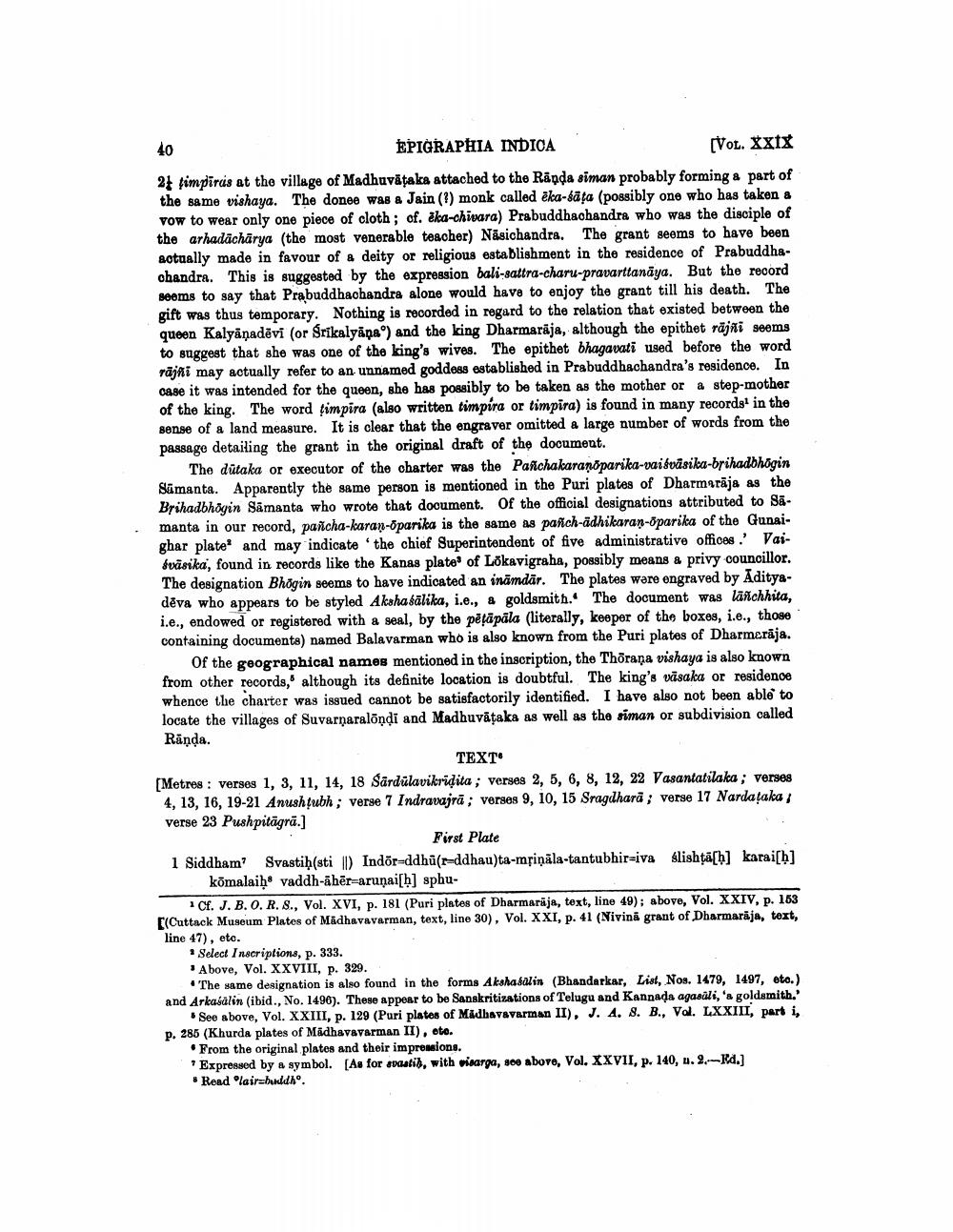________________
EPIGRAPHIA INDICA
[Vol. XXIX 21 fimpīrus at the village of Madhuvātaka attached to the Rända siman probably forming a part of the same vishaya. The doneo was a Jain (1) monk called ēka-safa (possibly one who has taken a vow to wear only one piece of cloth; of. Ska-chivara) Prabuddhachandra who was the disciple of the arhadācharya (the most venerable teacher) Nāsichandra. The grant seems to have been actually made in favour of a deity or religious establishment in the residence of Prabuddhachandra. This is suggested by the expression bali-sattra-charu-pravarttanāya. But the record seems to say that Prabuddhachandra alone would have to enjoy the grant till his death. The gift was thus temporary. Nothing is recorded in regard to the relation that existed between the queen Kalyanadēvi (or Srikalyana) and the king Dharmarāja, although the epithet rajñi seems to suggest that she was one of the king's wives. The epithet bhagavati used before the word rājni may actually refer to an unnamed goddess established in Prabuddhachandra's residence. In case it was intended for the queen, she has possibly to be taken as the mother or a step-mother of the king. The word (impira (also written timpira or timpira) is found in many records in the sense of a land measure. It is clear that the engraver omitted a large number of words from the passage detailing the grant in the original draft of the document.
The dütaka or executor of the charter was the Panchakaranoparika-vai sväsika-brihadbhogin Samanta. Apparently the same person is mentioned in the Puri plates of Dharmerāja as the Brihadbhögin Samanta who wrote that document. Of the official designations attributed to samanta in our record, pancha-karan-parika is the same as pañch-adhikaran-Oparika of the Gunaighar plate and may indicate the chief Superintendent of five administrative offices.' Vaifvasika, found in records like the Kanas plate of Lokavigraha, possibly means & privy councillor. The designation Bhögin seems to have indicated an ināmdār. The plates ware engraved by Adityadēva who appears to be styled Akshasālika, i.e., & goldsmith. The document was lastchhita, i.e., endowed or registered with a seal, by the pēļāpāla (literally, keeper of the boxes, i.e., those containing documents) named Balavarman who is also known from the Puri plates of Dharmerāja.
Of the geographical names mentioned in the inscription, the Thõraņa vishaya is also known from other records, although its definite location is doubtful. The king's vāsaka or residence whence the charter was issued cannot be satisfactorily identified. I have also not been able to locate the villages of Suvarṇaralöndi and Madhuvātaka as well as the siman or subdivision called Rända.
TEXT [Metres: verses 1, 3, 11, 14, 18 Sārdülavikridita ; verses 2, 5, 6, 8, 12, 22 Vasantatilaka; verses 4, 13, 16, 19-21 Anushțubh ; verse 7 Indravajrā ; verses 9, 10, 15 Sragdharà ; verse 17 Nardațaka ; verse 23 Pushpitägra.]
First Plate 1 Siddham? Svastiḥ(sti ) Indõr=ddhū(rddhau)ta-msiņāla-tantubhir=iva Slishţā[h] karai[h]
komalaih® vaddh-ahēr-arunaish] sphu
1 Cf. J.B.O.R.S.. Vol. XVI, p. 181 (Puri plates of Dharmaraja, text, line 49); above, Vol. XXIV. p. 163 C(Cuttack Museum Plates of Madhavavarman, text, line 30), Vol. XXI, p. 41 (Nivinā grant of Dharmaraja, text, line 47), eto.
* Select Inscriptions, p. 333.
Above, Vol. XXVIII, p. 329.
• The same designation is also found in the forms Akshafalin (Bhandarkar, List, Nos. 1479, 1497, eto.) and Arkasalin (ibid., No. 1496). These appear to be Sanskritizations of Telugu and Kannada agasali, 's goldsmith.'
See above, Vol. XXIII, p. 129 (Puri plates of Madhavavarman II), J. A. 8. B., Vol. LXXIII, parti, p. 286 (Khurda plates of Madhavavarman II), eto.
. From the original plates and their imprensione. * Expressed by a symbol. [As for spaatid, with visarga, 300 abore, Vol. XXVII, p. 140, u. 2.Rd.] . Read lair-bulda.




